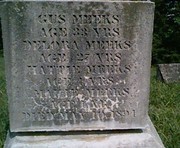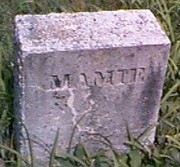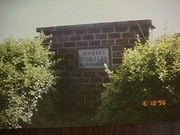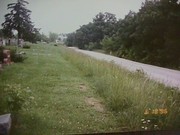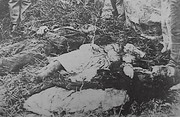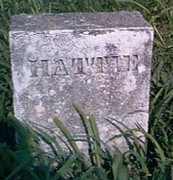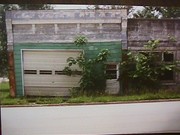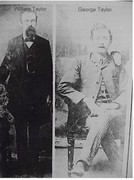Events
The events leading up to the murder of the Meeks family are quite complicated. George and William (Bill) Taylor were prominent citizens of the Milan/Browning area. William was cashier in the bank in Milan. Both men owned farms southeast of Browning, and Bill was a co-owner in the People's Bank in Browning. (See photo of bank remains in the green building.) However, they were being charged with forgery, arson, larceny and cattle rustling in Linn and Sullivan counties. Gus Meeks worked for them in the cattle operation, had plead guilty to rustling, and had been sentenced to the penitentiary. About a month before the murders, the governor pardoned Meeks in order to use him as a witness against the Taylors in other charges. Needless to say, the Taylors were anxious to be rid of him so that he could not testify against them.
Two weeks before the trial date, Bill Taylor arranged with Gus Meeks to get him to move out of the area. It was arranged that the Meeks family, for a team and wagon, and $1,000, would move out of the community. The plan was for the Taylors to move Gus Meeks away, to be driven to George Taylor's the first night, to remain there during the day, and the next night to make the drive out of the community (reportedly to Oklahoma). A letter to Meeks, written on letterhead from the People's Exchange Bank of Browning and signed by Bill Taylor saying "be ready at 10 o'clock," was given to authorities by Gus Meeks' mother, later as evidence.
On May 10, 1894, the two Taylor brothers took a wagon to the Meeks house, loaded them up in the back and headed in the direction of the Taylor farms, east of Browning. According to Nellie Meeks, the only survivor, "When we were going up the hill (the hill by Jenkins Cemetery), the man without whiskers (George) said his feet were cold and got out and walked along the side of the wagon and shot Papa, and Papa jumped out and started to run, then Mama screamed and started to jump when they shot Mama and sister. Then they hit me in the head, and I went to sleep." Nellie said that they (the Taylors) were met by two men in a buggy on the hill just before the murder.
The prints could be seen on the side of the road where bodies had fallen, and large pools of blood were on the grass and leaves at the side of the road. A tree with a bullet hole in it still stands in the timber north of the cemetery. Also found was a pistol with three chambers empty and the rock with which the smaller children had been killed.
The bodies were then loaded in the wagon and driven about two miles, coming into the field past George Taylor's house, through the meadow and were driven due west about 200 yards on the freshly planted corn ground. It arrived at an old straw pile where a grave about two feet wide, but 3 1/2 feet long and 16 inches deep had already been prepared for one body. All of them were thrown haphazardly into the "grave" and covered with hay.
After Nellie "went to sleep," as she said, she knew no more until thrown out of the wagon at the stack which seemed to arouse her. "When the man put me in the straw, the one with the whiskers kicked me on the back and said, 'They are all dead now, the ______!" The doctor who examined Nellie bore out her statement by the bruise on her back. "They covered me up and I could not breathe good. I heard them say it would not burn as it would not catch." She thought they were talking of burning the straw, but a woolen blanket was buried out at one side about ten feet, which had been on fire and was still smoldering when found.
About daylight, Nellie managed to crawl out from under the straw and the first house she saw was that of George Taylor. She started there, but looked around saw the Carter house much closer, went there, and tumbled into the house in a half dazed condition. She told her story to the amazed woman and 10-year-old boy who were there. She took the boy to the haystack, showed him the bodies and they returned to the Carters. Meanwhile, George Taylor was out harrowing his newly planted corn field trying to cover up the wagon tracks. The Carter woman sent the boy to tell the neighbors about he murders. He passed through the field by George and told him no to harrow the haystack because there were dead people under it. Taylor told the boy to come with him to his (Taylor's) house, and that he would hitch up a team and they would "go see." While the boy waited in the house, Taylor hitched the team and made a run for it to Browning. He was seen by various people traveling at a dead-run toward Browning and shortly thereafter, he was seen, with his brother William, headed east. Word was not received in Browning until an hour after the Taylors left.
The bodies remained in the haystack area until the coroner arrived from Bucklin about 5 p.m. the next day. They were then taken in rough coffins (still unwashed) to Milan where they were put on public display in the courthouse. Finding no local cemetery that would accept them, they were finally buried in one mass grave in the Bute Cemetery five miles SE of Owasco (NE of Milan). Separate markers were added for Hattie and Mamie. These photos were taken in May of 1998.
The Taylors had fled to Springfield, Mo., and then south to Chadwick. In about a month, they were in Arkansas where they were befriended/captured by Mr. Jerry South, a member of the Arkansas legislature. The Taylors convinced him that they would be found innocent at trial. He delivered them to St. Louis, where they went by train to St. Joseph, being met by rowdy lunch mobs in Moberly, Macon and Brookfield.
In subsequent trials, they were found guilty. George escaped jail in Carrollton, but Bill was hanged in 1896. Several "sightings" and claims to be Bill Taylor occurred over the next several years. One story supposedly had him living in Texas as a hermit. In another, a priest from the St. Louis area came to Linneus during the 1940's saying that he had heard a death-bed confession of a man who claimed to be George Taylor. This man lived on an island in the Mississippi River.
Stories and songs about the event became popular. Short books were even written.
(Information was compiled from various newspaper, personal, and other unofficial accounts of these events. This information is on file in the Linn R-1 Library, Purdin, Mo.)



